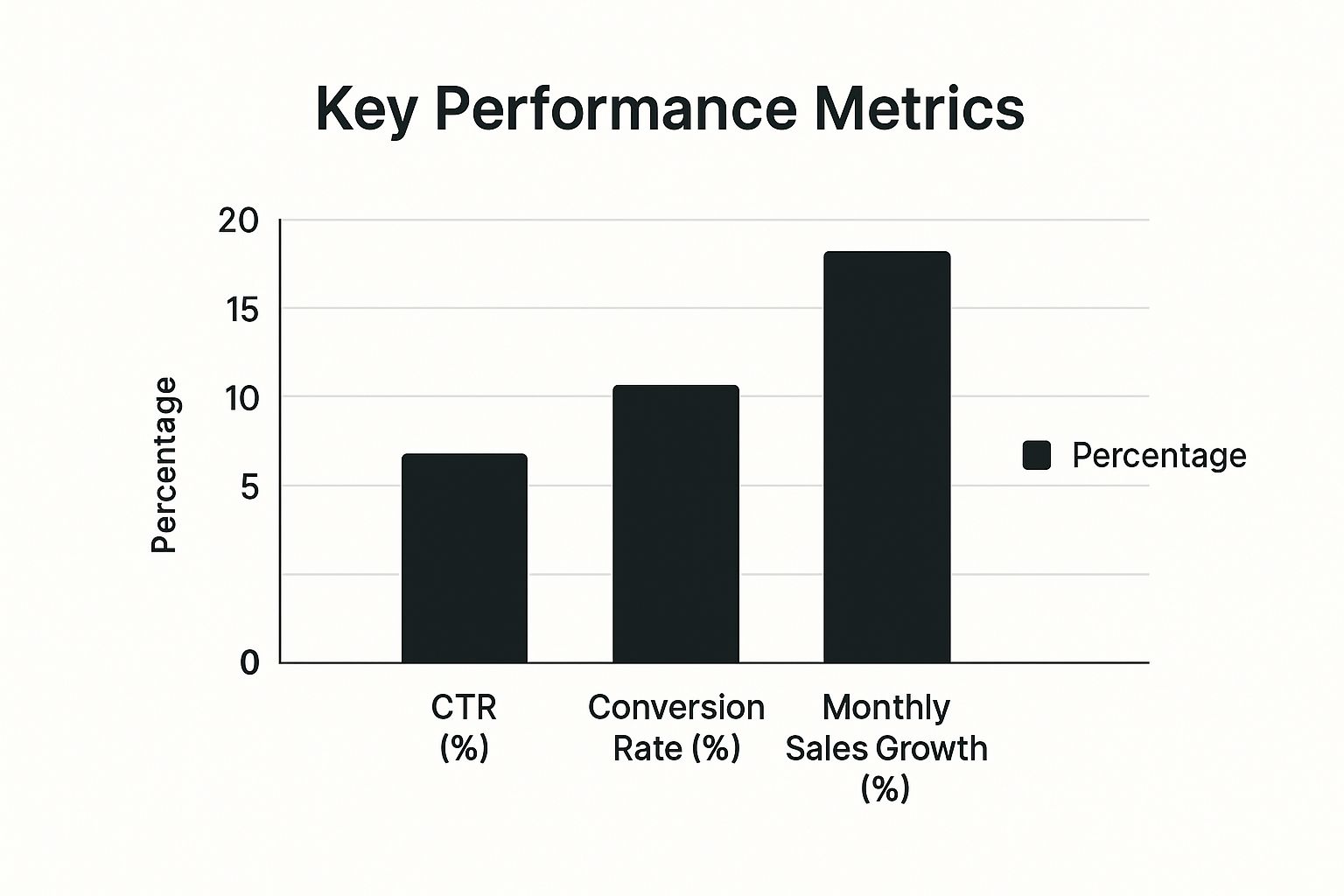Before you can even think about managing and scaling an affiliate program, you have to lay the groundwork. This isn't just about picking some software and hitting 'go.' It’s about being deliberate and strategic right from the beginning. A solid foundation is what separates programs that fizzle out from those that become powerful, long-term growth channels.
Building the Foundation for Your Affiliate Program

Jumping into recruitment without a clear plan is a recipe for chaos. It’s like building a house without a blueprint—you'll end up with a messy, unstable structure that doesn't serve its purpose. The first order of business is to define what success actually looks like for your business and align your affiliate program's goals directly with those core objectives.
Define Your Core Program Objectives
First things first: what are you trying to accomplish? Are you laser-focused on hitting a certain sales number? Or is your real goal to get your brand name out there in a new market? Maybe you just need a steady stream of qualified leads to keep your sales team busy.
Your answer to that question will dictate every other decision you make. For example:
- Driving Sales: If pure revenue is the name of the game, your world will revolve around conversion rates and boosting your average order value (AOV).
- Building Brand Awareness: When visibility is the priority, you'll be tracking metrics like social reach, impressions, and how many new customers you're reaching through your affiliates' audiences.
- Generating Leads: For a B2B SaaS company, a winning program might be measured by the number of high-quality trial sign-ups or demo requests it generates.
Getting this right from the start ensures your program delivers real, measurable value. It's a channel with massive potential. The affiliate marketing industry's global valuation hit around $18.5 billion in 2024 and is on track to reach a staggering $31.7 billion by 2031. This explosive growth is powered by the boom in ecommerce and smarter AI optimizations. You can explore more on how these affiliate marketing trends impact businesses and see the potential firsthand.
Design a Competitive Commission Structure
Let’s be honest—your commission structure is the hook. It's often the very first thing a potential partner looks at, and it needs to be compelling enough to grab their attention while still being sustainable for your profit margins. A generic, one-size-fits-all approach is a missed opportunity.
A well-designed commission structure does more than just pay for sales; it incentivizes the right behaviors. Consider a tiered model where affiliates earn a higher percentage as they drive more revenue, rewarding your top performers and encouraging others to grow.
For instance, you could offer a standard 15% commission that bumps up to 20% for any partner who drives over $5,000 in monthly sales. That simple structure creates a powerful, built-in incentive for affiliates to keep pushing.
Before you launch, it's a good idea to see how you stack up. Look at public directories or your competitors' affiliate pages to get a feel for the landscape. Clarity is everything.

As you can see in this example from a public directory, presenting your commission rates and program terms clearly helps potential partners quickly see if you're a good fit. When you're transparent and competitive, the best affiliates take notice.
Key Foundational Elements of an Affiliate Program
To tie it all together, here’s a quick summary of the core components you need to have in place. Thinking through each of these areas will give your program the structure it needs to succeed.
| Element | Key Consideration | Impact on Management |
|---|---|---|
| Program Objectives | Align with core business goals (e.g., sales, leads, awareness). | Guides KPI selection and helps measure true ROI. |
| Commission Structure | Must be competitive, sustainable, and motivating. | Directly influences partner attraction and performance. |
| Partnership Terms | Clear, fair, and legally sound agreement. | Reduces disputes and sets clear expectations from day one. |
| Tracking & Attribution | Reliable software with accurate cookie tracking. | Ensures fair credit for sales and builds partner trust. |
Nailing these foundational elements isn't just busywork; it's the strategic planning that prevents headaches down the road and sets you up to attract, manage, and scale a roster of high-performing partners.
Recruiting and Onboarding High-Value Partners

The partners you bring into your program will ultimately define its success. To really manage an affiliate program effectively, you have to get past the "more is better" mindset. It's all about quality over quantity.
Your true goal isn’t just to collect affiliates; it's to find partners whose audience is a direct reflection of your ideal customer. This calls for a targeted recruitment strategy, not just a generic "Apply Here" form on your website. Think of it as talent acquisition. You wouldn't hire a key team member without a plan, and the same principle applies here.
Start by creating a clear profile of your ideal affiliate. Are they a niche blogger who dives deep into specific topics? A YouTuber with a loyal, engaged following? Or a respected industry influencer?
Once you know exactly who you're looking for, it's time to start reaching out. Ditch the mass emails and personalize your approach. Mention a specific piece of their content and explain precisely why your product is a natural fit for their audience. This shows you've done your homework, builds real rapport, and dramatically boosts your chances of getting a yes. For more detailed strategies on this, our guide on https://refgrow.com/blog/how-to-recruit-affiliates is a great place to start.
Vetting for Quality and Brand Alignment
When potential partners express interest, the real work begins: the vetting process. This is your most critical quality control checkpoint. A careful review ensures you're partnering with people who will represent your brand ethically and effectively.
Your vetting checklist should hit these key points:
- Audience and Content Fit: Does their content genuinely align with your product? A mismatch here makes promotions feel awkward and, frankly, they just won't convert.
- Traffic Quality and Engagement: Use analytics tools to get a feel for their traffic sources. Is it coming from organic search and social media, or are they leaning on sketchy paid tactics? Look for active conversations in their comments section and community forums.
- Ethical Standards: Review their past promotions. Do they rely on clickbait, make over-the-top claims, or use high-pressure marketing tactics? These are major red flags that could damage your brand's reputation. Digging into techniques for identifying high-intent leads can also give you a framework for spotting quality partners.
Creating a Seamless Onboarding Experience
Recruitment is only half the battle. A smooth, welcoming onboarding experience is what transforms an interested partner into a confident and active promoter. The objective here is to remove all friction and arm them with everything they need to win right from the start.
Your affiliate onboarding should feel like a guided tour, not a scavenger hunt. The easier you make it for them to find assets, understand rules, and track performance, the faster they will start generating value.
This initial process is absolutely critical, especially when you consider that over 80% of brands now have affiliate programs. With 27.8% of all affiliate marketing driven through blogs, providing top-notch resources is how you stand out from the crowd.
A fantastic onboarding kit should always include:
- A simple welcome guide that clearly explains program rules and commission structures.
- A library of high-quality creative assets, like banners, logos, and professional product photos.
- Pre-written copy swipes and key talking points to make their first promotion easy.
- A direct line to your affiliate manager for any questions.
This upfront investment in recruiting and onboarding pays off massively. It lays the groundwork for strong, lasting partnerships that drive sustainable growth for your business.
Driving Performance with Proactive Communication and Support

If you want your affiliate program to really take off, you have to treat it like a partnership. Just approving affiliates and hoping for the best is a recipe for a flatlining program. It's the proactive communication—the constant back-and-forth—that truly fuels engagement, keeps your partners motivated, and ultimately drives more sales.
Think of your affiliates as a remote extension of your own marketing team. You wouldn't leave your in-house team in the dark, right? They need regular updates, clear goals, and the right resources to do their job well. This hands-on approach is what separates a program that just ticks along from one that becomes a serious revenue engine for your business.
Arm Your Partners with Compelling Resources
The single biggest thing you can do to set your affiliates up for success is to give them a fantastic library of creative assets. The less work they have to do to promote your brand effectively, the more likely they are to do it.
This means going way beyond a simple text link. A truly useful creative library is packed with everything they might need:
- High-Resolution Banners: Don't just upload a few standard sizes. Provide a whole suite of them in various designs that you've already tested and know get high click-through rates.
- Video Content: Short, snappy product demos, customer testimonials, or even b-roll footage can be gold. Make it easy for them to embed on their blog or share on social media.
- Email Swipe Copy: Save them a ton of time by drafting persuasive email templates they can quickly tweak for their own newsletters.
- Detailed Product Guides: Equip them with datasheets, feature comparisons, and key talking points. This helps them sound like an expert and answer audience questions with confidence.
When you hand them these tools on a silver platter, you remove all the friction from the process and ensure your brand is always presented professionally.
The best affiliate managers I know act more like coaches than administrators. Your job is to proactively give your partners everything they need to win, from killer creative assets to personalized feedback on what's working.
Cultivate Engagement Through Consistent Communication
Consistent, valuable communication keeps your program from getting lost in the noise. It shows your partners you're genuinely invested in seeing them succeed. A monthly affiliate newsletter is the perfect vehicle for this. It's your direct line to share performance tips, give a shout-out to top earners, and get everyone excited about upcoming product launches or seasonal promotions.
This steady outreach is a huge part of what makes the affiliate model so profitable. When you get it right, brands can see an average return on investment (ROI) of around $15 for every $1 spent, according to some industry data. You can dig into more numbers on this Wix.com affiliate marketing statistics page. That incredible return is almost always driven by a core group of highly engaged, well-supported partners.
Let's say you're launching a new feature next month. A week before launch, send out an email blast to your affiliates with all the exclusive details and some pre-written content they can use. This gives them a head start and makes them feel like true insiders. When you manage your program with that level of thoughtfulness, you build the kind of loyalty that motivates your entire network to go the extra mile.
Making Sense of the Numbers: How to Track, Analyze, and Grow Your Affiliate Program
If you want your affiliate program to do more than just exist, you have to get comfortable with the data. It’s easy to get distracted by vanity metrics like clicks and impressions, but real growth comes from focusing on the numbers that actually impact your bottom line. Think of your data as a strategic roadmap—it tells you where you are, where you’re going, and the best way to get there.
Your affiliate platform is a treasure trove of information, but you have to know what you’re looking for. Don’t just glance at the total sales for the month. Dig deeper. Look for patterns in your performance reports. Who are your top performers? Which affiliates are struggling? Where are the hidden opportunities for growth?
To get the full picture, you need to understand a wide range of crucial marketing performance metrics that go beyond just commissions paid out. This broader perspective helps you see the true impact of your affiliate partnerships.
The KPIs That Really Matter
Focusing on the right Key Performance Indicators (KPIs) is what separates a guessing game from a well-oiled machine. While total revenue is obviously important, other metrics often paint a much clearer picture of your program’s health and potential.
To get started, here's a breakdown of some essential KPIs I always recommend tracking for effective program analysis and optimization.
Essential KPIs for Affiliate Program Management
| KPI | What It Measures | Why It's Important |
|---|---|---|
| Conversion Rate (CR) | The percentage of clicks that result in a sale. | A high CR signals that an affiliate’s audience is a perfect match for your product and that their promotions are hitting the mark. |
| Average Order Value (AOV) | The average amount a customer spends in a single transaction. | Tracking AOV by affiliate helps you pinpoint partners who are successfully driving higher-value customers, not just more customers. |
| Return on Investment (ROI) | The ultimate measure of profitability for each partnership. | Calculating ROI (revenue generated vs. commissions paid) for individual affiliates shows you which relationships are the most financially rewarding. |
| Click-Through Rate (CTR) | The percentage of impressions that lead to a click. | This metric reflects how compelling your affiliate's promotional content is. Low CTR might mean the offer isn't positioned well. |
These metrics work together to tell a story. When you look at your data, you can start connecting the dots to figure out what's working and what isn't.
This visual really drives home how these metrics—CTR, Conversion Rate, and Sales Growth—interact.

As you can see, a strong conversion rate is often the most powerful lever you can pull to drive significant sales growth.
Turning Insights into Strategic Growth
Once you have a good handle on your data, you can start making smart, strategic moves to scale your program. Scaling isn't just about throwing more affiliates at the wall to see what sticks; it's about making your existing program more efficient and powerful.
The real goal of data analysis is to turn what you observe into action. If you notice a partner has a fantastic conversion rate but very little traffic, that’s your cue. Reach out and brainstorm a collaborative campaign to help boost their reach.
One of my favorite scaling strategies is introducing tiered commissions. This structure is a game-changer because it automatically rewards your best partners and motivates everyone else to step up their game.
Here’s a simple, real-world example of how you could set it up:
- Bronze Tier: 15% commission for affiliates generating up to $1,000 in monthly sales.
- Silver Tier: 20% commission for those generating $1,001 - $5,000 in monthly sales.
- Gold Tier: 25% commission for top performers who bring in over $5,000 a month.
This kind of structure creates a clear path for growth and gives your partners a tangible incentive to continuously improve. It's a true win-win that can fuel incredible, sustainable expansion for your program.
Navigating Common Affiliate Management Challenges
Let's be realistic: even the best-laid affiliate programs run into a few bumps in the road. If you're in this for the long haul, you have to be ready to handle the inevitable curveballs, from shady affiliate activity to partners who have gone completely silent.
The real secret is shifting from a reactive "firefighting" mode to a proactive one. Instead of waiting for problems to blow up, you anticipate them. You build systems and clear rules to deal with them quickly and fairly. This doesn't just protect your budget and your brand; it builds immense trust with the legitimate, hard-working partners you want to keep.
Tackling Affiliate Fraud Head-On
Affiliate fraud is a constant thorn in the side of any program manager, quietly siphoning off your marketing spend. Bad actors have a whole bag of tricks, but two of the most common schemes you'll see are cookie stuffing and click spam.
- Cookie Stuffing: Think of this as a digital pickpocket. A fraudster forces multiple affiliate cookies onto a user's browser without them ever clicking a link. The hope is that if the user eventually buys something, one of those cookies will get the credit.
- Click Spam: This is a brute-force attack. Scammers use bots to generate an insane number of fake clicks, trying to game the attribution system and steal commissions for sales they had zero influence on.
Your best defense is to get into the habit of regularly auditing your analytics. You're looking for anything that just doesn't add up. For example, an affiliate with a sky-high click-through rate but a 0% conversion rate is a massive red flag. A good affiliate platform should also have fraud detection tools that automatically flag this kind of suspicious activity for you to investigate.
Re-Engaging Dormant Partners
It happens all the time. An affiliate signs up, full of excitement, and then... crickets. They just never get going, or they start strong and then fade away. Don't just write them off as a loss. A smart re-engagement campaign can often bring them back to life.
First, figure out who you're talking to. An affiliate who used to make sales but has gone quiet needs a different touch than someone who never even placed a link. For the ones who were active, a quick personal email asking how things are going and offering some fresh banners or a temporary commission bump can work wonders. For those who never got off the ground, a simple "getting started" guide or an offer for a quick 15-minute strategy call might be all the push they need.
The goal is to reopen the lines of communication and remind them why they joined in the first place. A little personal attention can be the difference between a dead account and an active, revenue-generating partner.
Managing Commission Disputes with Transparency
Sooner or later, you're going to get an email from a partner asking about a missing commission. It can feel awkward, but how you handle it says everything about your program's integrity. When a dispute comes up, you have to approach it with total transparency and a commitment to being fair.
Dive into your tracking data right away to investigate. Whatever you find—a tracking glitch, a customer return, or a violation of your terms—explain it clearly. This is where having a rock-solid, detailed partnership agreement becomes your best friend. You can point directly to the clauses that apply to the situation. For a deeper dive, our guide to professional affiliate program management covers this in more detail. By following a consistent, rules-based process, you ensure everyone is treated the same, which is the cornerstone of trust.
Frequently Asked Questions About Affiliate Management
Jumping into affiliate marketing always stirs up a lot of questions. It doesn't matter if you're building a program from scratch or just trying to get more out of an existing one—getting straightforward answers to common roadblocks is key. Here, I'll tackle the most common questions we get from program managers every day.
My aim is to give you practical advice you can put to work right away. We’ll cover everything from figuring out what to pay your partners to the essential tools you'll need to keep things running smoothly.
How Much Should I Pay My Affiliates?
Figuring out the right commission rate is more of an art than a science. The "right" number really depends on your industry, your profit margins, and what a new customer is worth to you over time. The most popular model by far is Cost Per Sale (CPS), where you pay partners a percentage of every sale they drive.
A good first step is to see what your competitors are offering. You need to be competitive to attract the best partners, so a little market research goes a long way.
A fantastic strategy we've seen work time and again is setting up tiered commissions. This does more than just reward your top performers; it gives everyone a clear path to earning more. For example, you might start everyone at a 10% commission, but bump it up to 15% for anyone who generates over $5,000 in sales that month.
This kind of structure builds motivation right into your program and encourages affiliates to keep pushing for better results.
What Are the Must-Have Tools for Management?
To run an affiliate program without pulling your hair out, you need the right technology. At the heart of it all is your affiliate management software or a network platform. Think of tools like ShareASale, CJ Affiliate, or Impact. These platforms are absolutely essential for handling the heavy lifting:
- Tracking sales and referrals accurately
- Giving you detailed performance reports
- Automating commission payouts
Beyond that central hub, an email service provider is a must for keeping in touch with your partners. Sending out regular newsletters with program news, fresh creative assets, or promotion tips is one of the best ways to keep your affiliates active and engaged. And don't forget a well-organized library of creative assets—banners, product images, and pre-written copy—to make it easy for them to promote you.
How Do I Effectively Prevent Affiliate Fraud?
Preventing fraud isn't a one-and-done task; it requires a proactive and layered strategy. It all starts with your application process. Take the time to manually review every single affiliate who applies to your program. This initial screening is your best first defense against bad actors.
Next, make sure your affiliate software has solid fraud detection features. These systems can automatically spot red flags, like a massive spike in clicks with no conversions, which is a classic sign of click spam. You should also get in the habit of regularly reviewing your own performance data to spot any weird patterns.
Most importantly, your program's terms of service need to be ironclad. Spell out exactly what you consider fraud (like bidding on your brand name in ads or using adware) and what the consequences are. This should always include immediate removal from the program and forfeiture of any pending commissions. If you're looking for more tips on building a secure foundation, check out our guide on how to create an affiliate program.
Ready to launch, track, and scale a powerful affiliate program directly within your SaaS? With Refgrow, you can set up a fully native, customizable referral dashboard in minutes. Join over 1,600 businesses and see how seamless affiliate management can be. Explore Refgrow today.

